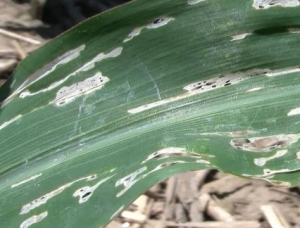By Peter Coffey, Agriculture Agent Associate
University of Maryland Extension, Carroll County

Well, it’s finally starting to feel like spring, and that means it’s time to talk slugs. There are 15 species of slug in Maryland, but only four are common in field crops, and the most troublesome one seems to be, Deroceras reticulatum, the gray garden slug (Figure 1). It’s light grey and can be up to 2 inches long. It can handle a bit dryer conditions than most slugs, which allows it to become a problem in field crops. Economic thresholds for slugs are hard to determine because the crop has the entire year to overcome any damage that doesn’t kill it. In general, young plants can tolerate a large amount of damage, at least 40% defoliation in corn, and 50% in soybeans.
Most slug damage occurs during the first month after planting, and large populations can devastate seedlings. Slugs have a rasping mouthpart, and feed by scraping the surface of leaves. This appears first as “window pane” damage in corn (Figure 2), and can worsen into shredded leaves. Slugs cannot dig, which means the growing point of the corn plant (which is belowground) is protected, meaning corn can outgrow heavy damage with low yield loss. However, the plant is still stressed, and may be more sensitive to bad weather while growing through the damage. Slug-damaged cereals tend to tiller more, compensating for damage, but if the population of slugs is high enough, yield can still be affected.

In soybeans, slugs create craters in the cotyledons, holes in the leaves, and can snip the growing meristem. Soybean seedlings can’t recover from a severed meristem, and so slugs can lead to significantly reduced stand counts. Protecting the meristem is why making sure your seed slot is closed when planting is so important. If the seed slot isn’t closed slugs will travel along it, eating the young meristems as they emerge, killing soybeans and corn.
Because slugs dry out so easily they are particular about their field environment. This is why you may notice slugs are always a problem in the same fields. Overall, priority for slug scouting should be given to: 1) fields with a history of slug problems, 2) fields with abundant surface residue, and 3) fields that are low-lying, with heavy soil. Look for slime trains, and turn over crop litter. Slugs are more active at night, so night scouting is most effective.
Neonicotinoid seed treatments are ineffective against slugs, and make the slugs poisonous to predatory beetles, which are their primary natural enemies. If you have a field with a history of slug problems, consider planting untreated seed if you can get it. Metaldehyde (Deadline), baits are the standard treatment, but tend to be water soluble, so their window of efficacy may be brief. Iron phosphate (Sluggo) is an OMRI approved alternative, but it is more expensive. Thirty percent urea mixed with equal parts water applied at 20 gal/acre will kill slugs, however, it is only effective if it contacts the slugs directly. This means that the most effective application is at night when there is no wind, and the temperature is mild because that is when slugs will be most exposed. Repeat applications may be necessary in areas with high populations. Also, don’t forget urea is a source of nitrogen, so this would need to comply with your nutrient management plan!
